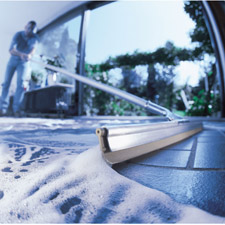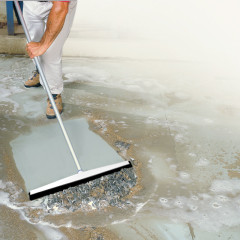How To Clean Up Water On Floor
How to Clean up After a Flood
 A flood is a devastating disaster in itself, but if left untreated, can lead to even farther harm. Standing water and wet floors tin apace become a breeding ground for bacteria and mold if non cleaned upwardly finer.
A flood is a devastating disaster in itself, but if left untreated, can lead to even farther harm. Standing water and wet floors tin apace become a breeding ground for bacteria and mold if non cleaned upwardly finer.
Alluvion water may also contain sewage from overflowed or flare-up pipes, making it even more critical that you accept the proper steps in protecting yourself and your family during the cleanup process.
Flood Cleanup – Before You Offset:
- Keep children and pets out of the area until inundation cleanup is consummate and you've determined it'due south condom for them to enter the affected area.
- E'er habiliment rubber or other non-porous boots, gloves, and eye protection when working in the expanse.
Walk through the affected area to identify which items are salvageable and which are non.
- While hard to part with personal belongings, if they tin't be washed and disinfected yous will demand to remove and destroy them.
- Common items that can't exist disinfected include mattresses, pillows, carpeting, rugs, books, cosmetics, baby toys, and upholstered furniture.
- Drywall and insulation likewise tin can't be disinfected subsequently they come up in contact with sewage or flood waters and should be removed and destroyed.
Finding the Right Tool 
To remove the h2o and debris from the flooring, Unger Professional floor squeegees are platonic for removing large volumes of water or debris and can exist used on a variety of surfaces such every bit asphalt, tile, concrete, and linoleum. They are ordinarily used for both residential and commercial tasks when there is a lot of area to clean and dry.
The type of squeegee to use for water removal depends on the type of flooring.
Uneven floor, like tile and asphalt: A foam squeegee is best because the soft cream rubber blade tin arrange to the cleaning surface.
Smooth flooring, like concrete and asphalt: A squeegee with a rubber blade is the best tool for the task.
Begin the Water Removal Process
Once you have the right floor squeegee, y'all tin can brainstorm the h2o removal process.
- To finer motion h2o and droppings, pull (don't push) the squeegee for all-time results.
- Begin at the border, moving the liquid and droppings towards a drain.
- If at that place isn't a drain within the area, move the liquid and droppings into a pool so that you can then use a bucket and pan for removal.
- Continually tap squeegee to remove excess liquid or dirt.
Once the water has been removed:
- Wash the floor surface with soap and warm, clean water.
- The floor squeegee can keep to be used for this process.
- Next, sanitize the surface with household bleach.
- Mix one cup of bleach with 5 gallons of h2o in a large bucket.
- Apply the flooring squeegee to spread the bleach mixture on the flooring to sanitize the surface.
- Allow the bleach to sanitize the floor, practice not rinse with h2o, just permit information technology air dry out.
If there was mold growth on the floor surface:
- You will need to use a stronger bleach batter by mixing 1 cup of bleach for every 1 gallon of h2o in a bucket.
- Wash the floor surface with the bleach mixture.
- Use a heavy duty brush, such as the Unger Professional person HydroPower Bi-Level Scrub Brush or Unger Professional person Outdoor Scrub Brush to scrub the floor make clean.
- And then, rinse the surface with clean h2o and allow to air dry.
Next, make clean and sanitize all other difficult surfaces with hot h2o and soap:
- Laundry or dish soap are suitable for basic cleaning but to sanitize, bleach is necessary.
- Later on you have cleaned with the soap, rinse the surface with clean water.
- So, add i loving cup of bleach for every ane gallon of clean water in a bucket.
- Sanitize the surface with this concoction and allow to air dry out.
- Food surfaces that may have come into contact with the flood water should follow the aforementioned cleanup procedure.
- But only use 1 teaspoon of bleach for every gallon of bleach.
If yous have a dehumidifier, this is ideal in helping with the drying process and preventing mold growth. Y'all can also use fans or air conditioner units to keep the air moving within the afflicted area.
In one case the flood cleanup is complete, wash your easily thoroughly with soap and warm water. Yous should likewise wash all wearing apparel that were worn during the flood cleanup in hot h2o and detergent. Launder these clothes separate from the remainder of your laundry. However, earlier using your washing motorcar, accept your onsite waste-h2o system professionally inspected and serviced.
For more cleaning tips from the professionals, visit our Resources folio.
How To Clean Up Water On Floor,
Source: https://ungerconsumer.com/professional-cleaning-tips/how-to-clean-up-after-a-flood/
Posted by: gomerabst1968.blogspot.com


0 Response to "How To Clean Up Water On Floor"
Post a Comment